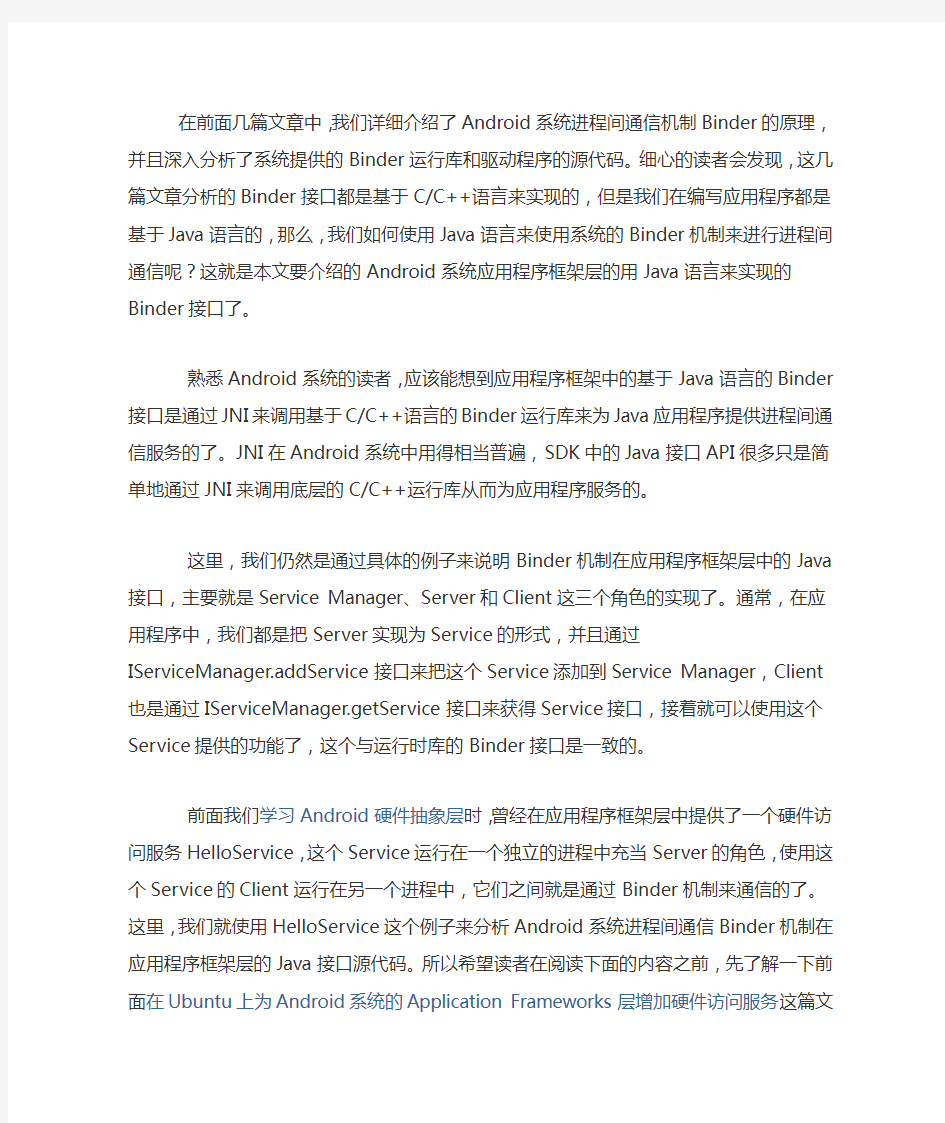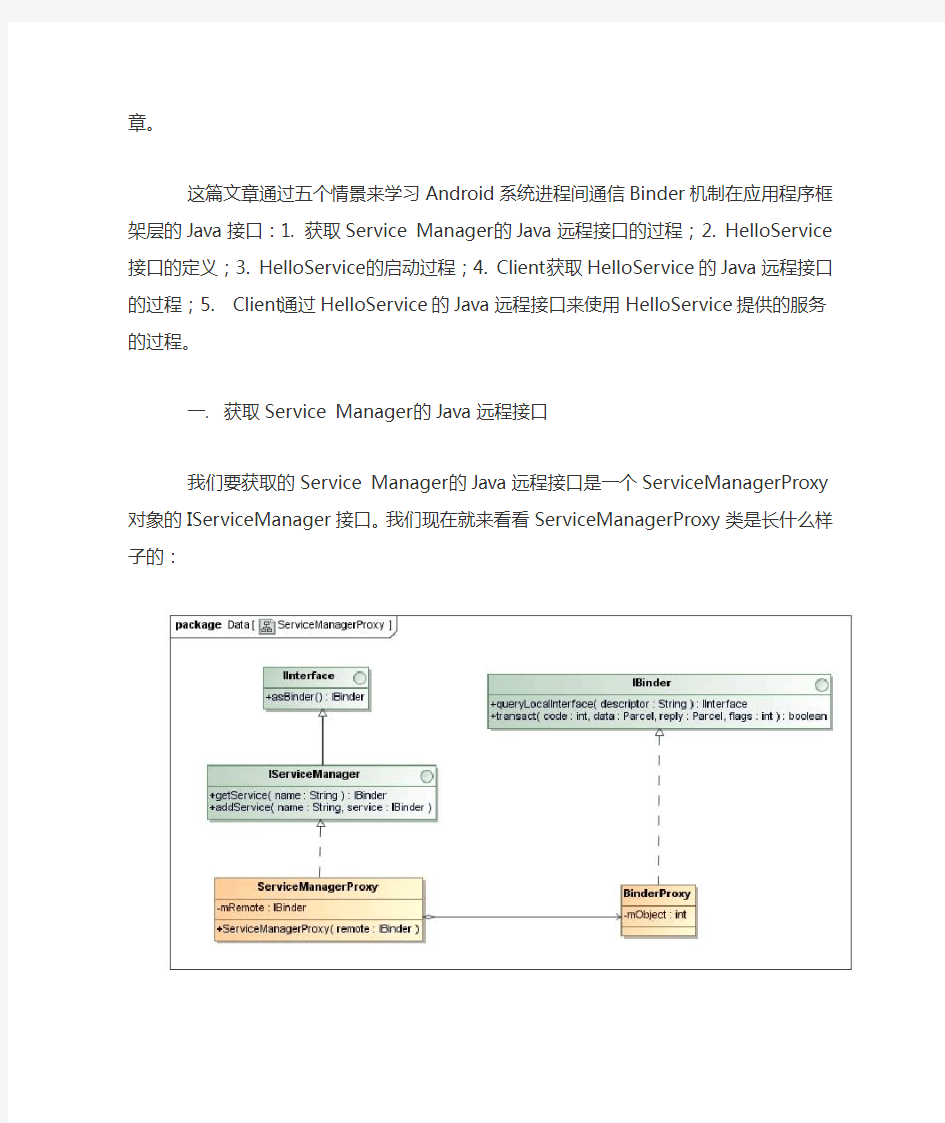

在前面几篇文章中,我们详细介绍了Android系统进程间通信机制Binder的原理,并且深入分析了系统提供的Binder运行库和驱动程序的源代码。细心的读者会发现,这几篇文章分析的Binder接口都是基于C/C++语言来实现的,但是我们在编写应用程序都是基于Java语言的,那么,我们如何使用Java语言来使用系统的Binder机制来进行进程间通信呢?这就是本文要介绍的Android系统应用程序框架层的用Java语言来实现的Binder接口了。
熟悉Android系统的读者,应该能想到应用程序框架中的基于Java语言的Binder接口是通过JNI来调用基于C/C++语言的Binder运行库来为Java应用程序提供进程间通信服务的了。JNI在Android系统中用得相当普遍,SDK中的Java 接口API很多只是简单地通过JNI来调用底层的C/C++运行库从而为应用程序服务的。
这里,我们仍然是通过具体的例子来说明Binder机制在应用程序框架层中的Java接口,主要就是Service Manager、Server和Client这三个角色的实现了。通常,在应用程序中,我们都是把Server实现为Service的形式,并且通过IServiceManager.addService接口来把这个Service添加到Service Manager,Client也是通过IServiceManager.getService接口来获得Service接口,接着就可以使用这个Service提供的功能了,这个与运行时库的Binder接口是一致的。
前面我们学习Android硬件抽象层时,曾经在应用程序框架层中提供了一个硬件访问服务HelloService,这个Service运行在一个独立的进程中充当Server的角色,使用这个Service的Client运行在另一个进程中,它们之间就是通过Binder机制来通信的了。这里,我们就使用HelloService这个例子来分析Android系统进程间通信Binder机制在应用程序框架层的Java接口源代码。所以希望读者在阅读下面的内容之前,先了解一下前面在Ubuntu上为Android系统的Application Frameworks层增加硬件访问服务这篇文章。
这篇文章通过五个情景来学习Android系统进程间通信Binder机制在应用程序框架层的Java接口:1. 获取Service Manager的Java远程接口的过程;2. HelloService接口的定义;3. HelloService的启动过程;4. Client获取HelloService 的Java远程接口的过程;5. Client通过HelloService的Java远程接口来使用HelloService提供的服务的过程。
一. 获取Service Manager的Java远程接口
我们要获取的Service Manager的Java远程接口是一个ServiceManagerProxy对象的IServiceManager接口。我们现在就来看看ServiceManagerProxy类是长什么样子的:
这里可以看出,ServiceManagerProxy类实现了IServiceManager接口,IServiceManager提供了getService和addService两个成员函数来管理系统中的Service。从ServiceManagerProxy类的构造函数可以看出,它需要一个BinderProxy 对象的IBinder接口来作为参数。因此,要获取Service Manager的Java远程接口ServiceManagerProxy,首先要有一个BinderProxy对象。下面将会看到这个BinderProxy对象是如何获得的。
再来看一下是通过什么路径来获取Service Manager的Java远程接口ServiceManagerProxy的。这个主角就是ServiceManager了,我们也先看一下ServiceManager是长什么样子的:
ServiceManager类有一个静态成员函数getIServiceManager,它的作用就是用来获取Service Manager的Java远程接口了,而这个函数又是通过ServiceManagerNative来获取Service Manager的Java远程接口的。
接下来,我们就看一下ServiceManager.getIServiceManager这个函数的实现,这个函数定义在frameworks/base/core/java/android/os/ServiceManager.java 文件中:
view plain
1.public final class ServiceManager {
2. ......
3.private static IServiceManager sServiceManager;
4. ......
5.private static IServiceManager getIServiceManager() {
6.if (sServiceManager != null) {
7.return sServiceManager;
8. }
9.
10.// Find the service manager
11. sServiceManager = ServiceManagerNative.asInterface(BinderInternal.ge
tContextObject());
12.return sServiceManager;
13. }
14. ......
15.}
如果其静态成员变量sServiceManager尚未创建,那么就调用ServiceManagerNative.asInterface函数来创建。在调用ServiceManagerNative.asInterface函数之前,首先要通过
BinderInternal.getContextObject函数来获得一个BinderProxy对象。
我们来看一下BinderInternal.getContextObject的实现,这个函数定义在frameworks/base/core/java/com/android/internal/os/BinderInternal.java文件中:
view plain
1.public class BinderInternal {
2. ......
3./**
4. * Return the global "context object" of the system. This is usually
5. * an implementation of IServiceManager, which you can use to find
6. * other services.
7. */
8.public static final native IBinder getContextObject();
9.
10. ......
11.}
这里可以看出,BinderInternal.getContextObject是一个JNI方法,它实现在frameworks/base/core/jni/android_util_Binder.cpp文件中:
view plain
1.static jobject android_os_BinderInternal_getContextObject(JNIEnv* env, jobje
ct clazz)
2.{
3. sp
4.return javaObjectForIBinder(env, b);
5.}
这里看到我们熟悉的ProcessState::self()->getContextObject函数,具体可以参考浅谈Android系统进程间通信(IPC)机制Binder中的Server和Client获得
Service Manager接口之路一文。ProcessState::self()->getContextObject函数返回一个BpBinder对象,它的句柄值是0,即下面语句:
view plain
1.sp
相当于是:
view plain
1.sp
接着调用javaObjectForIBinder把这个BpBinder对象转换成一个BinderProxy对象:
view plain
1.jobject javaObjectForIBinder(JNIEnv* env, const sp
2.{
3.if (val == NULL) return NULL;
4.
5.if (val->checkSubclass(&gBinderOffsets)) {
6.// One of our own!
7. jobject object = static_cast
8.//printf("objectForBinder %p: it's our own %p!\n", val.get(), object
);
9.return object;
10. }
11.
12.// For the rest of the function we will hold this lock, to serialize
13.// looking/creation of Java proxies for native Binder proxies.
14. AutoMutex _l(mProxyLock);
15.
16.// Someone else's... do we know about it?
17. jobject object = (jobject)val->findObject(&gBinderProxyOffsets);
18.if (object != NULL) {
19. jobject res = env->CallObjectMethod(object, gWeakReferenceOffsets.mG
et);
20.if (res != NULL) {
21. LOGV("objectForBinder %p: found existing %p!\n", val.get(), res)
;
22.return res;
23. }
24. LOGV("Proxy object %p of IBinder %p no longer in working set!!!", ob
ject, val.get());
25. android_atomic_dec(&gNumProxyRefs);
26. val->detachObject(&gBinderProxyOffsets);
27. env->DeleteGlobalRef(object);
28. }
29.
30. object = env->NewObject(gBinderProxyOffsets.mClass, gBinderProxyOffsets.
mConstructor);
31.if (object != NULL) {
32. LOGV("objectForBinder %p: created new %p!\n", val.get(), object);
33.// The proxy holds a reference to the native object.
34. env->SetIntField(object, gBinderProxyOffsets.mObject, (int)val.get()
);
35. val->incStrong(object);
36.
37.// The native object needs to hold a weak reference back to the
38.// proxy, so we can retrieve the same proxy if it is still active.
39. jobject refObject = env->NewGlobalRef(
40. env->GetObjectField(object, gBinderProxyOffsets.mSelf));
41. val->attachObject(&gBinderProxyOffsets, refObject,
42. jnienv_to_javavm(env), proxy_cleanup);
43.
44.// Note that a new object reference has been created.
45. android_atomic_inc(&gNumProxyRefs);
46. incRefsCreated(env);
47. }
48.
49.return object;
50.}
在介绍这个函数之前,先来看两个变量gBinderOffsets和gBinderProxyOffsets的定义。
先看gBinderOffsets的定义:
view plain
1.static struct bindernative_offsets_t
2.{
3.// Class state.
4. jclass mClass;
5. jmethodID mExecTransact;
6.
7.// Object state.
8. jfieldID mObject;
9.
10.} gBinderOffsets;
简单来说,gBinderOffsets变量是用来记录上面第二个类图中的Binder类的相关信息的,它是在注册Binder类的JNI方法的int_register_android_os_Binder 函数初始化的:
view plain
1.const char* const kBinderPathName = "android/os/Binder";
2.
3.static int int_register_android_os_Binder(JNIEnv* env)
4.{
5. jclass clazz;
6.
7. clazz = env->FindClass(kBinderPathName);
8. LOG_FATAL_IF(clazz == NULL, "Unable to find class android.os.Binder");
9.
10. gBinderOffsets.mClass = (jclass) env->NewGlobalRef(clazz);
11. gBinderOffsets.mExecTransact
12. = env->GetMethodID(clazz, "execTransact", "(IIII)Z");
13. assert(gBinderOffsets.mExecTransact);
14.
15. gBinderOffsets.mObject
16. = env->GetFieldID(clazz, "mObject", "I");
17. assert(gBinderOffsets.mObject);
18.
19.return AndroidRuntime::registerNativeMethods(
20. env, kBinderPathName,
21. gBinderMethods, NELEM(gBinderMethods));
22.}
再来看gBinderProxyOffsets的定义:
view plain
1.static struct binderproxy_offsets_t
2.{
3.// Class state.
4. jclass mClass;
5. jmethodID mConstructor;
6. jmethodID mSendDeathNotice;
7.
8.// Object state.
9. jfieldID mObject;
10. jfieldID mSelf;
11.
12.} gBinderProxyOffsets;
简单来说,gBinderProxyOffsets是用来变量是用来记录上面第一个图中的BinderProxy类的相关信息的,它是在注册BinderProxy类的JNI方法的
int_register_android_os_BinderProxy函数初始化的:
view plain
1.const char* const kBinderProxyPathName = "android/os/BinderProxy";
2.
3.static int int_register_android_os_BinderProxy(JNIEnv* env)
4.{
5. jclass clazz;
6.
7. clazz = env->FindClass("java/lang/ref/WeakReference");
8. LOG_FATAL_IF(clazz == NULL, "Unable to find class https://www.doczj.com/doc/0a14402232.html,ng.ref.WeakRefe
rence");
9. gWeakReferenceOffsets.mClass = (jclass) env->NewGlobalRef(clazz);
10. gWeakReferenceOffsets.mGet
11. = env->GetMethodID(clazz, "get", "()Ljava/lang/Object;");
12. assert(gWeakReferenceOffsets.mGet);
13.
14. clazz = env->FindClass("java/lang/Error");
15. LOG_FATAL_IF(clazz == NULL, "Unable to find class https://www.doczj.com/doc/0a14402232.html,ng.Error");
16. gErrorOffsets.mClass = (jclass) env->NewGlobalRef(clazz);
17.
18. clazz = env->FindClass(kBinderProxyPathName);
19. LOG_FATAL_IF(clazz == NULL, "Unable to find class android.os.BinderProxy
");
20.
21. gBinderProxyOffsets.mClass = (jclass) env->NewGlobalRef(clazz);
22. gBinderProxyOffsets.mConstructor
23. = env->GetMethodID(clazz, "
24. assert(gBinderProxyOffsets.mConstructor);
25. gBinderProxyOffsets.mSendDeathNotice
26. = env->GetStaticMethodID(clazz, "sendDeathNotice", "(Landroid/os/IBi
nder$DeathRecipient;)V");
27. assert(gBinderProxyOffsets.mSendDeathNotice);
28.
29. gBinderProxyOffsets.mObject
30. = env->GetFieldID(clazz, "mObject", "I");
31. assert(gBinderProxyOffsets.mObject);
32. gBinderProxyOffsets.mSelf
33. = env->GetFieldID(clazz, "mSelf", "Ljava/lang/ref/WeakReference;");
34. assert(gBinderProxyOffsets.mSelf);
35.
36.return AndroidRuntime::registerNativeMethods(
37. env, kBinderProxyPathName,
38. gBinderProxyMethods, NELEM(gBinderProxyMethods));
39.}
回到前面的javaObjectForIBinder函数中,下面这段代码:
view plain
1.if (val->checkSubclass(&gBinderOffsets)) {
2.// One of our own!
3. jobject object = static_cast
4.//printf("objectForBinder %p: it's our own %p!\n", val.get(), object);
5.return object;
6.}
前面说过,这里传进来的参数是一个BpBinder的指针,而
BpBinder::checkSubclass继承于父类IBinder::checkSubclass,它什么也不做就返回false。
于是函数继续往下执行:
view plain
1.jobject object = (jobject)val->findObject(&gBinderProxyOffsets);
由于这个BpBinder对象是第一创建,它里面什么对象也没有,因此,这里返回的object为NULL。
于是函数又继续往下执行:
view plain
1.object = env->NewObject(gBinderProxyOffsets.mClass, gBinderProxyOffsets.mCon
structor);
这里,就创建了一个BinderProxy对象了。创建了之后,要把这个BpBinder 对象和这个BinderProxy对象关联起来:
view plain
1.env->SetIntField(object, gBinderProxyOffsets.mObject, (int)val.get());
就是通过BinderProxy.mObject成员变量来关联的了,BinderProxy.mObject 成员变量记录了这个BpBinder对象的地址。
接下去,还要把它放到BpBinder里面去,下次就要使用时,就可以在上一步调用BpBinder::findObj把它找回来了:
view plain
1.val->attachObject(&gBinderProxyOffsets, refObject,
2. jnienv_to_javavm(env), proxy_cleanup);
最后,就把这个BinderProxy返回到
android_os_BinderInternal_getContextObject函数,最终返回到最开始的ServiceManager.getIServiceManager函数中来了,于是,我们就获得一个BinderProxy对象了。
回到ServiceManager.getIServiceManager中,从下面语句返回:
view plain
1.sServiceManager = ServiceManagerNative.asInterface(BinderInternal.getContext
Object());
相当于是:
view plain
1.sServiceManager = ServiceManagerNative.asInterface(new BinderProxy());
接下去就是调用ServiceManagerNative.asInterface函数了,这个函数定义在frameworks/base/core/java/android/os/ServiceManagerNative.java文件中:
view plain
1.public abstract class ServiceManagerNative ......
2.{
3. ......
4.static public IServiceManager asInterface(IBinder obj)
5. {
6.if (obj == null) {
7.return null;
8. }
9. IServiceManager in =
10. (IServiceManager)obj.queryLocalInterface(descriptor);
11.if (in != null) {
12.return in;
13. }
14.
15.return new ServiceManagerProxy(obj);
16. }
17. ......
18.}
这里的参数obj是一个BinderProxy对象,它的queryLocalInterface函数返回null。因此,最终以这个BinderProxy对象为参数创建一个ServiceManagerProxy 对象。
返回到ServiceManager.getIServiceManager中,从下面语句返回:
view plain
1.sServiceManager = ServiceManagerNative.asInterface(new BinderProxy());
就相当于是:
view plain
1.sServiceManager = new ServiceManagerProxy(new BinderProxy());
于是,我们的目标终于完成了。
总结一下,就是在Java层,我们拥有了一个Service Manager远程接口ServiceManagerProxy,而这个ServiceManagerProxy对象在JNI层有一个句柄值为0的BpBinder对象与之通过gBinderProxyOffsets关联起来。
这样获取Service Manager的Java远程接口的过程就完成了。
二. HelloService接口的定义
前面我们在学习Android系统的硬件抽象层(HAL)时,在在Ubuntu上为Android系统的Application Frameworks层增加硬件访问服务这篇文章中,我们编写了一个硬件服务HelloService,它的服务接口定义在
frameworks/base/core/java/android/os/IHelloService.aidl文件中:
view plain
1.package android.os;
2.
3.interface IHelloService
4.{
5.void setVal(int val);
6.int getVal();
7.}
这个服务接口很简单,只有两个函数,分别用来读写硬件寄存器。
注意,这是一个aidl文件,编译后会生成一个IHelloService.java。我们来看一下这个文件的内容隐藏着什么奥秘,可以这么神奇地支持进程间通信。
view plain
1./*
2. * This file is auto-generated. DO NOT MODIFY.
3. * Original file: frameworks/base/core/java/android/os/IHelloService.aidl
4. */
5.package android.os;
6.public interface IHelloService extends android.os.IInterface
7.{
8./** Local-side IPC implementation stub class. */
9.public static abstract class Stub extends android.os.Binder implements a
ndroid.os.IHelloService
10. {
11.private static final https://www.doczj.com/doc/0a14402232.html,ng.String DESCRIPTOR = "android.os.IHell
oService";
12./** Construct the stub at attach it to the interface. */
13.public Stub()
14. {
15.this.attachInterface(this, DESCRIPTOR);
16. }
17.
18./**
19. * Cast an IBinder object into an android.os.IHelloService interface,
20. * generating a proxy if needed.
21. */
22.public static android.os.IHelloService asInterface(android.os.IBinde
r obj)
23. {
24.if ((obj==null)) {
25.return null;
26. }
27. android.os.IInterface iin = (android.os.IInterface)obj.queryLoca
lInterface(DESCRIPTOR);
28.if (((iin!=null)&&(iin instanceof android.os.IHelloService))) {
29.return ((android.os.IHelloService)iin);
30. }
31.return new android.os.IHelloService.Stub.Proxy(obj);
32. }
33.
34.public android.os.IBinder asBinder()
35. {
36.return this;
37. }
38.
39.@Override
40.public boolean onTransact(int code, android.os.Parcel data, android.
os.Parcel reply, int flags) throws android.os.RemoteException
41. {
42.switch (code)
43. {
44.case INTERFACE_TRANSACTION:
45. {
46. reply.writeString(DESCRIPTOR);
47.return true;
48. }
49.case TRANSACTION_setVal:
50. {
51. data.enforceInterface(DESCRIPTOR);
52.int _arg0;
53. _arg0 = data.readInt();
54.this.setVal(_arg0);
55. reply.writeNoException();
56.return true;
57. }
58.case TRANSACTION_getVal:
59. {
60. data.enforceInterface(DESCRIPTOR);
61.int _result = this.getVal();
62. reply.writeNoException();
63. reply.writeInt(_result);
64.return true;
65. }
66. }
67.return super.onTransact(code, data, reply, flags);
68. }
69.
70.private static class Proxy implements android.os.IHelloService
71. {
72.private android.os.IBinder mRemote;
73.
74. Proxy(android.os.IBinder remote)
75. {
76. mRemote = remote;
77. }
78.
79.public android.os.IBinder asBinder()
80. {
81.return mRemote;
82. }
83.
84.public https://www.doczj.com/doc/0a14402232.html,ng.String getInterfaceDescriptor()
85. {
86.return DESCRIPTOR;
87. }
88.
89.public void setVal(int val) throws android.os.RemoteException
90. {
91. android.os.Parcel _data = android.os.Parcel.obtain();
92. android.os.Parcel _reply = android.os.Parcel.obtain();
93.try {
94. _data.writeInterfaceToken(DESCRIPTOR);
95. _data.writeInt(val);
96. mRemote.transact(Stub.TRANSACTION_setVal, _data, _reply,
0);
97. _reply.readException();
98. }
99.finally {
100. _reply.recycle();
101. _data.recycle();
102. }
103. }
104.
105.public int getVal() throws android.os.RemoteException
106. {
107. android.os.Parcel _data = android.os.Parcel.obtain();
108. android.os.Parcel _reply = android.os.Parcel.obtain();
109.int _result;
110.try {
111. _data.writeInterfaceToken(DESCRIPTOR);
112. mRemote.transact(Stub.TRANSACTION_getVal, _data, _reply , 0);
113. _reply.readException();
114. _result = _reply.readInt();
115. }
116.finally {
117. _reply.recycle();
118. _data.recycle();
119. }
120.return _result;
121. }
122. }
123.
124.static final int TRANSACTION_setVal = (android.os.IBinder.FIRST_CAL L_TRANSACTION + 0);
125.static final int TRANSACTION_getVal = (android.os.IBinder.FIRST_CAL L_TRANSACTION + 1);
126. }
127.
128.public void setVal(int val) throws android.os.RemoteException;
129.public int getVal() throws android.os.RemoteException;
130.}
这里我们可以看到IHelloService.aidl这个文件编译后的真面目,原来就是根据IHelloService接口的定义生成相应的Stub和Proxy类,这个就是我们熟悉的Binder机制的内容了,即实现这个HelloService的Server必须继续于这里的IHelloService.Stub类,而这个HelloService的远程接口就是这里的IHelloService.Stub.Proxy对象获得的IHelloService接口。接下来的内容,我们就可以看到IHelloService.Stub和IHelloService.Stub.Proxy是怎么创建或者使用的。
三. HelloService的启动过程
在讨论HelloService的启动过程之前,我们先来看一下实现HelloService接口的Server是怎么定义的。
回忆在Ubuntu上为Android系统的Application Frameworks层增加硬件访问服务一文,我们在frameworks/base/services/java/com/android/server目录下新增了一个HelloService.java文件:
view plain
1.package com.android.server;
2.
3.import android.content.Context;
4.import android.os.IHelloService;
5.import android.util.Slog;
6.
7.public class HelloService extends IHelloService.Stub {
8.private static final String TAG = "HelloService";
9.
10. HelloService() {
11. init_native();
12. }
13.
14.public void setVal(int val) {
15. setVal_native(val);
16. }
17.
18.public int getVal() {
19.return getVal_native();
20. }
21.
22.private static native boolean init_native();
23.private static native void setVal_native(int val);
24.private static native int getVal_native();
25.}
这里,我们可以看到,HelloService继续了IHelloService.Stub类,它通过本地方法调用实现了getVal和setVal两个函数。我们不关心这两个函数的具体实现,有兴趣的读者可以参考在Ubuntu上为Android系统的Application Frameworks层增加硬件访问服务一文。
有了HelloService这个Server类后,下一步就是考虑怎么样把它启动起来了。在frameworks/base/services/java/com/android/server/SystemServer.java文件中,定义了SystemServer类。SystemServer对象是在系统启动的时候创建的,它被创建的时候会启动一个线程来创建HelloService,并且把它添加到Service Manager 守护进程中去,最后进入一个循环,等待Client的请求。
我们来看一下这部份的代码:
view plain
1.class ServerThread extends Thread {
2. ......
3.
4.@Override
5.public void run() {
6.
7. ......
8.
9. Looper.prepare();
10.
11. ......
12.
13.try {
14. Slog.i(TAG, "Hello Service");
15. ServiceManager.addService("hello", new HelloService());
16. } catch (Throwable e) {
17. Slog.e(TAG, "Failure starting Hello Service", e);
18. }
19.
20. ......
21.
22. Looper.loop();
23.
24. ......
25. }
26.}
27.
28.......
29.
30.public class SystemServer
31.{
32. ......
33.
34./**
35. * This method is called from Zygote to initialize the system. This will
cause the native
36. * services (SurfaceFlinger, AudioFlinger, etc..) to be started. After th
at it will call back
37. * up into init2() to start the Android services.
38. */
39.native public static void init1(String[] args);
40.
41. ......
42.
43.public static final void init2() {
44. Slog.i(TAG, "Entered the Android system server!");
45. Thread thr = new ServerThread();
46. thr.setName("android.server.ServerThread");
47. thr.start();
48. }
49. ......
50.}
这里,我们可以看到,在ServerThread.run函数中,执行了下面代码把HelloService添加到Service Manager中去,并且通过Looper.loop进入循环等待Client的请求。这里我们关注把HelloService添加到Service Manager中去的代码:
view plain
1.try {
2. Slog.i(TAG, "Hello Service");
3. ServiceManager.addService("hello", new HelloService());
4.} catch (Throwable e) {
5. Slog.e(TAG, "Failure starting Hello Service", e);
6.}
通过调用ServiceManager.addService把一个HelloService实例添加到Service Manager中去。
我们先来看一下HelloService的创建过程:
view plain
1.new HelloService();
这个语句会调用HelloService类的构造函数,而HelloService类继承于IHelloService.Stub类,IHelloService.Stub类又继承了Binder类,因此,最后会调用Binder类的构造函数:
view plain
1.public class Binder implements IBinder {
2. ......
3.
4.private int mObject;
5.
6. ......
7.
8.
9.public Binder() {
10. init();
11. ......
12. }
13.
14.
15.private native final void init();
16.
17.
18. ......
19.}
这里调用了一个JNI方法init来初始化这个Binder对象,这个JNI方法定义在frameworks/base/core/jni/android_util_Binder.cpp文件中:
view plain
1.static void android_os_Binder_init(JNIEnv* env, jobject clazz)
2.{
3. JavaBBinderHolder* jbh = new JavaBBinderHolder(env, clazz);
4.if (jbh == NULL) {
5. jniThrowException(env, "java/lang/OutOfMemoryError", NULL);
6.return;
7. }
8. LOGV("Java Binder %p: acquiring first ref on holder %p", clazz, jbh);
9. jbh->incStrong(clazz);
10. env->SetIntField(clazz, gBinderOffsets.mObject, (int)jbh);
11.}
它实际上只做了一件事情,就是创建一个JavaBBinderHolder对象jbh,然后把这个对象的地址保存在上面的Binder类的mObject成员变量中,后面我们会用到。
回到ServerThread.run函数中,我们再来看一下
ServiceManager.addService函数的实现:
view plain
1.public final class ServiceManager {
2. ......
3.
4.private static IServiceManager sServiceManager;
5.
6. ......
7.
8.public static void addService(String name, IBinder service) {
9.try {
10. getIServiceManager().addService(name, service);
11. } catch (RemoteException e) {
12. Log.e(TAG, "error in addService", e);
13. }
14. }
15.
16. ......
17.
18.}
这里的getIServiceManager函数我们在前面已经分析过了,它返回的是一个ServiceManagerProxy对象的IServiceManager接口。因此,我们进入到ServiceManagerProxy.addService中去看看:
view plain
1.class ServiceManagerProxy implements IServiceManager {
2.public ServiceManagerProxy(IBinder remote) {
3. mRemote = remote;
4. }
5.
6. ......
7.
8.public void addService(String name, IBinder service)
9.throws RemoteException {
10. Parcel data = Parcel.obtain();
11. Parcel reply = Parcel.obtain();
12. data.writeInterfaceToken(IServiceManager.descriptor);
13. data.writeString(name);
14. data.writeStrongBinder(service);
15. mRemote.transact(ADD_SERVICE_TRANSACTION, data, reply, 0);
16. reply.recycle();
17. data.recycle();
18. }
19.
20. ......
21.
22.private IBinder mRemote;